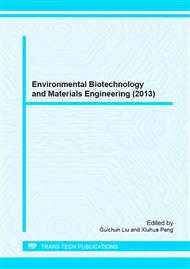[1]
Choi, J.H., Fukushi, K., Ng, H.Y., Yamamoto, K. (2006) Evaluation of a long-term operation of a submerged nanofiltration membrane bioreactor (NF MBR) for advanced wastewater treatment. Water Sci. Technol. 53(6), 131-136.
DOI: 10.2166/wst.2006.185
Google Scholar
[2]
Wyffels, S., Pynaert, K., Boeckx, P., Verstraete, W., Van Cleemput, O. (2003) Identification and quantification of nitrogen removal in a rotating biological contactor by N-15 tracer techniques. Water Res. 37(6), 1252-1259.
DOI: 10.1016/s0043-1354(02)00485-2
Google Scholar
[3]
Leon S, Downing, Robert Nerenberg (2008) Total nitrogen removal in a hybrid, membrane-aerated activated sludge process. Water Res. 42(14), 3697-3708.
DOI: 10.1016/j.watres.2008.06.006
Google Scholar
[4]
Xia, S.Q., Li, J.Y., Wang, R.C. (2008) Nitrogen removal performance and microbial community structure dynamics response to carbon nitrogen ratio in a compact suspended carrier biofilm reactor. Ecological Engineering 32(3), 256-262.
DOI: 10.1016/j.ecoleng.2007.11.013
Google Scholar
[5]
Wu, C.Y., Phengpasirth Bounpadith, et al. (2008) Effect of loading on organic matter removal and nitrification in membrane aeration bioreactor. Industrial Water & Wastewater 39(1): 41-44(in Chinese).
Google Scholar
[6]
Astrid A. van de G, Peter de B, et al. (1997) Metabolic pathway of anaerobic ammonium oxidation on the basis of 15N studies in a fluidized bed reactor. Microbiology 143(7): 2415-2421.
DOI: 10.1099/00221287-143-7-2415
Google Scholar
[7]
State Environmental Protection Administration (2002) Standards of Water and Wastewater Analysis. Bei Jing: China Environmental Science Press, (in Chinese).
Google Scholar
[8]
Cai, Y.L., Zhou Y.Z., Wai, H.Y. (2005) The characteristic of the phosphorus anaerobic release from activated sludge in different substrates with MDAT-IAT process. Acta Scientiae Circumstantiae 25(7): 913-917(in Chinese).
Google Scholar
[9]
Ouyang, K., Liu, J.X. (2009) Analysis of Characteristics of Microbial Communities in Membrane Bioreactor and Conventional Activated Sludge Process. Chinese Journal of Environmental Science 30(2): 499-503(in Chinese).
Google Scholar
[10]
Schramm A (2000) Microenvironments and distribution of nitrifying bacteria in a membrane-bound biofilm. Environ. Microbiol. 2(6): 680-686.
DOI: 10.1046/j.1462-2920.2000.00150.x
Google Scholar
[11]
Magurran A.E. (1988) Ecological diversity and its measurement. New Jersey: Princeton University Press.
Google Scholar
[12]
Osaka, T., Yoshie, S., Tsuneda, S. (2006) Identification of Acetate- or Methanol-Assimilating Bacteria under Nitrate-Reducing Conditions by Stable-Isotope Probing. Microb. Ecol. 52(2): 253-266.
DOI: 10.1007/s00248-006-9071-7
Google Scholar
[13]
Y, L., L, Y.J., W, G.J. (2008) Identification of novel denitrifying bacteria Stenotrophomonas sp. ZZ15 and Oceanimonas sp. YC13 and application for removal of nitrate from industrial wastewater. Biodegradation 20(3): 391-400.
DOI: 10.1007/s10532-008-9230-2
Google Scholar
[14]
Han, C.H., Meng Z.G. (2006) Application of a new biomaterial-polyhydroxyalkanoates to solid-phase denitrification of w astewater. China water & wastewater 22(18): 4-7(in Chinese).
Google Scholar
[15]
Liu, H.B. (2007) Enhaneed denitrifying phosphorus removing of low strength municipal wastewater treatment-process development and mechanisms study on the parallel AN/AO process. Shanghai: Tongji University (in Chinese).
Google Scholar
[16]
Hector F. Castro, Aimee T. Classen, Emily E. Austin. (2010) Soil Microbial Community Responses to Multiple Experimental Climate Change Drivers. Applied and environmental microbiology 76(4): 999-1007.
DOI: 10.1128/aem.02874-09
Google Scholar
[17]
Newton R.J., McMahon K.D. (2010) Seasonal differences in bacterial community composition following nutrient additions in a eutrophic lake. Environ. Microbiol. 10(2): 1462-2920.
DOI: 10.1111/j.1462-2920.2010.02387.x
Google Scholar
[18]
X, Y., K, Y.H., Trine R T. (2008).
Google Scholar
[19]
Liu XY, Wang BJ, Jiang CY. (2007) Simultaneous biodegradation of nitrogen-containing aromatic compounds in a sequencing batch bioreactor. J Environ Sci, 19(5): 530-535.
DOI: 10.1016/s1001-0742(07)60088-6
Google Scholar
[20]
Hoshino T., Terahara T., Tsuneda S. (2005) Molecular analysis of microbial population transition associated with the start of denitrification in a wastewater treatment process. Applied Microbiology 99(5): 1165-1175.
DOI: 10.1111/j.1365-2672.2005.02698.x
Google Scholar
[21]
Xi, L.Q., Zhang, D.G., Yao, T. (2007) Uingn isotopic dilution method to determine the quantification of association nitrogen fixation bacteria soil from oat roots. Journal of Nuclear Agricultural Sciences 21(4): 417-420 (in Chinese).
Google Scholar
[22]
Riviere, D., Desvignes, V., Pelletier, E. (2009) Towards the definition of a core of microorganisms involved in anaerobic digestion of sludge. ISME J 3(6): 700-714.
DOI: 10.1038/ismej.2009.2
Google Scholar
[23]
Ziembińska A, Ciesielski S, Miksch K. (2009) Ammonia oxidizing bacteria community in activated sludge monitored by denaturing gradient gel electrophoresis (DGGE) [J]. J Gen Appl. Microbiol. 55(5): 373-380.
DOI: 10.2323/jgam.55.373
Google Scholar


